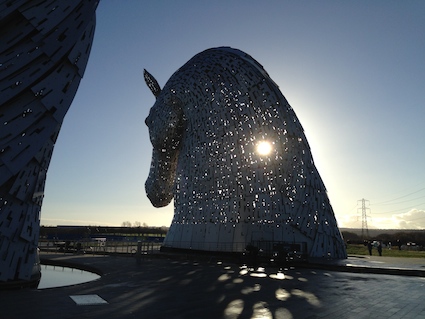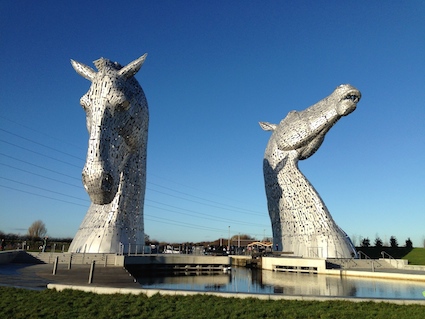
It is impossible to ignore The Kelpies. These huge sculptures immediately attract your attention when driving past Falkirk on the M9 motorway. Finally Scotland has a piece of roadside public art with a “wow” factor. They are unmissable, unforgettable and very, very horsey.
The sculptures are located beside the Union Canal. Each horse weighs around 300 tonnes and is about 30m high. Two Glasgow-based Clydesdale horses, Duke and Baron, were used as models and the history of working horses have been a strong driver behind the project. Prior to the use of coal, big horses such as Clydesdales not only worked on the land as “living machinery” but pulled boats along the Union Canal from coast to coast.

The Kelpies are the work of Andy Scott, a Scottish sculptor, who is world-renowned for his landmark artworks. The attention to detail is evident in all of Andy’s work and here you can see this on a large scale. It is possible to enter the Kelpies and see the frame and lighting set up – for the sculptures are also lit up at night from the inside as well as out. Each piece of laser-cut steel riveted together appears to be different. The use of steel is deliberate. It is a reminder of this former industry which was so prominent in Scotland until recent times. The sculptures were erected in just 90 days – a remarkable design and engineering feat.

The sculptures are contemporary monuments and reflect the industrial history of Central Scotland. Yet naming the sculptures “Kelpies” adds further interest and significance. Kelpies are mythical and supernatural beasts, that supposedly had the strength of 100 ordinary horses. Kelpies haunt Scottish lochs, rivers and waterways. These water horses are often said to be dark grey, black or white with dripping manes. Occasionally seaweed may be found tangled within their long wet manes. The kelpies have skin as smooth as seals but very cold to touch. So the choice of cold grey steel is appropriate for the sculptures.
Kelpies disguise themselves as lost horses and hang about by stretches of water waiting for an unsuspecting victim – a wandering traveller or child out playing late. The fatal mistake is to look at a kelpie. They are known to enchant humans.
They encourage a person to mount their backs. When this happens, the unfortunate rider discovers that they are now glued to the skin of the kelpie, unable to escape. As the kelpie plunges into the depths of the water, thunder can be heard rolling across the glens. After the rider drowns, the kelpie eats its victim and legend has it that children are particularly tasty.

So these sculptures serve not only to remind passing motorists of the historical significance of steel, the Union Canal and the industrial history of this part of Scotland. They capture the imagination of many through keeping alive a Scottish legend that serves to act as a cautionary tale to children who choose to play near water! I wonder how children would chose re-tell and create their own stories after a visit to The Kelpies.





























